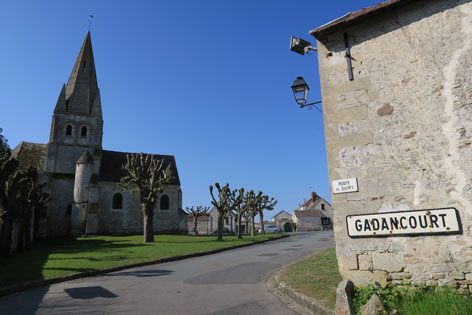Prochain point : lat="49.09839" lon="1.85645"

THE VILLAGE HEART
Deep ties with religion
A village that grew up...
The spelling of the village’s name changed successively, from Wadancourt to Vadancourt to Gadencourt and finally Gadancourt. The town was merged with the neighbouring town of Avernes on January 1st 2018. It grew up around the Saint-Martin church, the chateau, the priory, the large farm and the presbytery. The oldest buildings are the 13th century church, and the 18th century tithe barn, of which only a gable remains, now integrated into a more recent agricultural construction. The initial construction for the chateau was carried out by Jean de Hazeville at the end of the 17th century. It has been listed as a heritage monument since 1948. A dovecote, now gone, was built in the 16th century.
Near the church, there was once even a court for the ball game
jeu de paume (a forerunner of tennis), as can be seen on an old postcard. Originally played with bare hands, or a leather glove, it was later played with rackets.
…around the old presbutery
This charming residence built in Roman concrete with sandstone quoins is the old presbytery, said to date back to the 18th century. It housed the parish priest and his vicars. Aside from the stairways, the building is symmetrical, with nine segmental arched windows, framed with cut stone and two brick chimney stacks standing on gables. Access to the property is gained via a carriage gate or a pedestrian passage. Not far off, behind the church, within the chateau’s annexes, the ruins of the old Bernadine priory can be found, no doubt dating from the end of the 13th century. Rumour has it that the Bernadine monks came to Gadancourt to clear the Royal forest of Arthies, the northern limit of which was marked by the bell tower. The proiry was probably attached to the Saint-Lô priory of Rouen, which owned land in Gadancourt. Before 1750, the priory housed ten monks.





